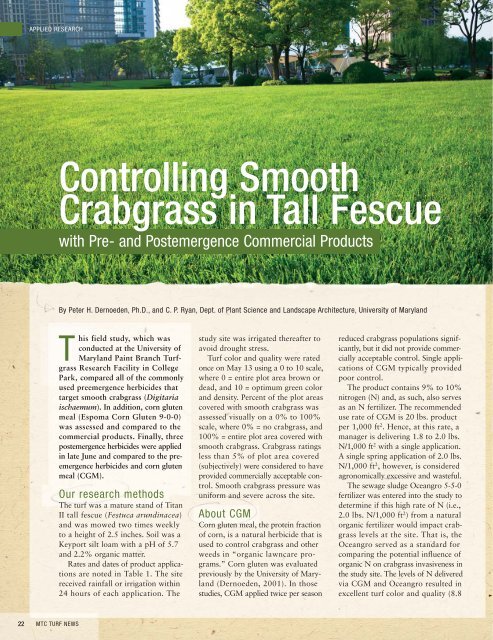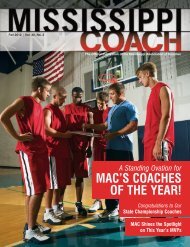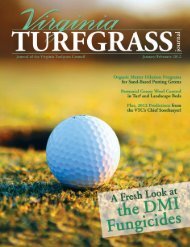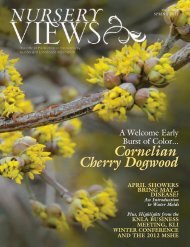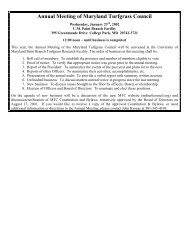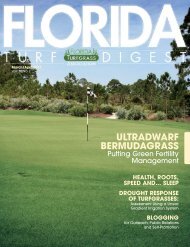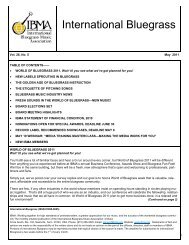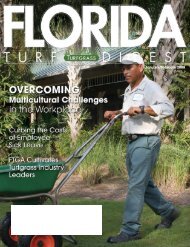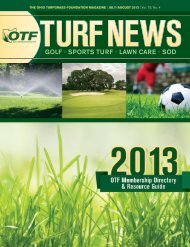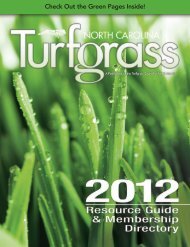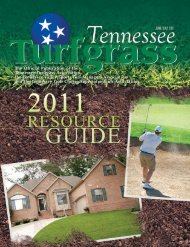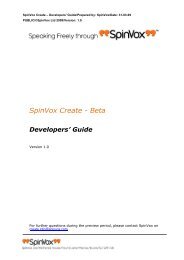the Fate of Field Paspalum Control - The Paginator
the Fate of Field Paspalum Control - The Paginator
the Fate of Field Paspalum Control - The Paginator
You also want an ePaper? Increase the reach of your titles
YUMPU automatically turns print PDFs into web optimized ePapers that Google loves.
APPLIED RESEARCH<br />
<strong>Control</strong>ling Smooth<br />
Crabgrass in Tall Fescue<br />
with Pre- and Postemergence Commercial Products<br />
By Peter H. Dernoeden, Ph.D., and C. P. Ryan, Dept. <strong>of</strong> Plant Science and Landscape Architecture, University <strong>of</strong> Maryland<br />
This field study, which was<br />
conducted at <strong>the</strong> University <strong>of</strong><br />
Maryland Paint Branch Turfgrass<br />
Research Facility in College<br />
Park, compared all <strong>of</strong> <strong>the</strong> commonly<br />
used preemergence herbicides that<br />
target smooth crabgrass (Digitaria<br />
ischaemum). In addition, corn gluten<br />
meal (Espoma Corn Gluten 9-0-0)<br />
was assessed and compared to <strong>the</strong><br />
commercial products. Finally, three<br />
postemergence herbicides were applied<br />
in late June and compared to <strong>the</strong> preemergence<br />
herbicides and corn gluten<br />
meal (CGM).<br />
Our research methods<br />
<strong>The</strong> turf was a mature stand <strong>of</strong> Titan<br />
II tall fescue (Festuca arundinacea)<br />
and was mowed two times weekly<br />
to a height <strong>of</strong> 2.5 inches. Soil was a<br />
Keyport silt loam with a pH <strong>of</strong> 5.7<br />
and 2.2% organic matter.<br />
Rates and dates <strong>of</strong> product applications<br />
are noted in Table 1. <strong>The</strong> site<br />
received rainfall or irrigation within<br />
24 hours <strong>of</strong> each application. <strong>The</strong><br />
study site was irrigated <strong>the</strong>reafter to<br />
avoid drought stress.<br />
Turf color and quality were rated<br />
once on May 13 using a 0 to 10 scale,<br />
where 0 = entire plot area brown or<br />
dead, and 10 = optimum green color<br />
and density. Percent <strong>of</strong> <strong>the</strong> plot areas<br />
covered with smooth crabgrass was<br />
assessed visually on a 0% to 100%<br />
scale, where 0% = no crabgrass, and<br />
100% = entire plot area covered with<br />
smooth crabgrass. Crabgrass ratings<br />
less than 5% <strong>of</strong> plot area covered<br />
(subjectively) were considered to have<br />
provided commercially acceptable control.<br />
Smooth crabgrass pressure was<br />
uniform and severe across <strong>the</strong> site.<br />
About CGM<br />
Corn gluten meal, <strong>the</strong> protein fraction<br />
<strong>of</strong> corn, is a natural herbicide that is<br />
used to control crabgrass and o<strong>the</strong>r<br />
weeds in “organic lawncare programs.”<br />
Corn gluten was evaluated<br />
previously by <strong>the</strong> University <strong>of</strong> Maryland<br />
(Dernoeden, 2001). In those<br />
studies, CGM applied twice per season<br />
reduced crabgrass populations significantly,<br />
but it did not provide commercially<br />
acceptable control. Single applications<br />
<strong>of</strong> CGM typically provided<br />
poor control.<br />
<strong>The</strong> product contains 9% to 10%<br />
nitrogen (N) and, as such, also serves<br />
as an N fertilizer. <strong>The</strong> recommended<br />
use rate <strong>of</strong> CGM is 20 lbs. product<br />
per 1,000 ft 2 . Hence, at this rate, a<br />
manager is delivering 1.8 to 2.0 lbs.<br />
N/1,000 ft 2 with a single application.<br />
A single spring application <strong>of</strong> 2.0 lbs.<br />
N/1,000 ft 2 , however, is considered<br />
agronomically excessive and wasteful.<br />
<strong>The</strong> sewage sludge Oceangro 5-5-0<br />
fertilizer was entered into <strong>the</strong> study to<br />
determine if this high rate <strong>of</strong> N (i.e.,<br />
2.0 lbs. N/1,000 ft 2 ) from a natural<br />
organic fertilizer would impact crabgrass<br />
levels at <strong>the</strong> site. That is, <strong>the</strong><br />
Oceangro served as a standard for<br />
comparing <strong>the</strong> potential influence <strong>of</strong><br />
organic N on crabgrass invasiveness in<br />
<strong>the</strong> study site. <strong>The</strong> levels <strong>of</strong> N delivered<br />
via CGM and Oceangro resulted in<br />
excellent turf color and quality (8.8<br />
22 MTC TURF NEWS


